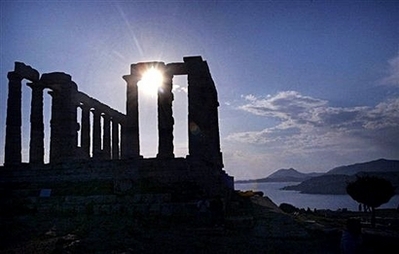Tsunami that devastated the ancient world could return
(Agencies)
Updated: 2008-03-10 07:06
Updated: 2008-03-10 07:06
PARIS - "The sea was driven back, and its waters flowed away to such an extent that the deep sea bed was laid bare and many kinds of sea creatures could be seen," wrote Roman historian Ammianus Marcellus, awed at a tsunami that struck the then-thriving port of Alexandria in 365 AD.
 A view of the ancient Temple of Poseidon at Cape Sounion, south of Athens, in 2004. "The sea was driven back, and its waters flowed away to such an extent that the deep sea bed was laid bare and many kinds of sea creatures could be seen," wrote Roman historian Ammianus Marcellus, awed at a tsunami that struck the then-thriving port of Alexandria in 365 AD. [Agencies] |
"Huge masses of water flowed back when least expected, and now overwhelmed and killed many thousands of people... Some great ships were hurled by the fury of the waves onto the rooftops, and others were thrown up to two miles (three kilometres) from the shore."
Ancient documents show the great waves of July 21, 365 AD claimed lives from Greece, Sicily and Alexandria in Egypt to modern-day Dubrovnik in the Adriatic.
Swamped by sea water, rich Nile delta farmland was abandoned and hilltop towns became ghost-like, inhabited only by hermits.
The tsunami was generated by a massive quake that occurred under the western tip of the Greek island of Crete, experts believe.
Until now, the main thinking has been that this quake -- as in the Indian Ocean tsunami of December 26, 2004 -- occurred in a so-called subduction zone.
A subduction zone is where two of the Earth's plates meet. One plate rides over another plate which is gliding downward at an angle into the planet's mantle.
Subduction zones usually have measurable creep, of say a few centimetres (inches) a year. But as the rock becomes brittle and deformed at greater depths, these zones can also deliver titanic quakes, displacing so much land that, when the slippage occurs on the ocean floor, a killer wave is generated.
The 365 AD quake occurred at a point on the 500-kilometre (300-mile) -long Hellenic subduction zone, which snakes along the Mediterranean floor in a semi-circle from southwestern Turkey to western Greece.
Researchers in Britain have taken a fresh look at this event and have come up with some worrying news.
University of Cambridge professor Beth Shaw carried out a computer simulation of the quake, based especially on fieldwork in Crete where the push forced up land by as much as 10 metres (32.5 feet).
They estimate the quake to have been 8.3-8.5 magnitude and that its land displacement -- of 20 metres (65 feet) on average -- puts it in the same category as the 9.3 temblor that occurred off Sumatra in 2004.
They conclude the slippage occurred along 100 kilometres (about 60 miles) on a previously unidentified fault that lies close to the surface, just above the subduction zone.
The quake happened at a depth of around 45 kilometres (30 miles) -- around 30 kilometres (20 miles) closer to the surface than would have been likely if the slip had occurred on the subduction fault itself.
After the 365 AD quake, the fault is likely to remain quiet for around 5,000 years.
But if the tectonic structure along the rest of the Hellenic subduction zone is similar, a tsunami-generating quake could strike the eastern Mediterranean in roughly 800 years, the scientists estimate.
The last tsunami to hit the eastern Mediterranean occurred on August 8, 1303. According to research published in 2006, a quake off Crete of about 7.8 magnitude hit Alexandria 40 minutes later with a wave nine metres (29.25 feet) high.
"That there has been only one other such event... in the past 1,650 years should focus our attention on the modern-day tsunami hazard in the eastern Mediterranean," the new study, published in the journal Nature Geoscience, warns.
"Repetition of such an event would have catastrophic consequences for today's densely-populated Mediterranean coastal regions."
The UN Educational, Scientific and Cultural Organisation (UNESCO) is setting up a tsunami alert system for the Mediterranean as part of a global network established after the 2004 Indian Ocean disaster.
|
|
|
||
|
||
|
|
|
|